STEREO REVIEW'S SELECTION OF RECORDINGS OF SPECIAL MERIT--BEST OF THE MONTH
Instrumental: Schoenberg's five string quartets ... Opera: Verdi's Simon Boccanegra. Orchestral: Haydn's Symphonies Nos. 43 and 59 ... Vocal: Ray Charles' "True to Life," Jane Olivor's "Chasing Rainbows," John Stewart's "Fire in the Wind"
The Schoenberg Quartets: Have They Mellowed Over the Years?
COLUMBIA has just presented us with the five Schoenberg string quartets in excellent new recordings by the "new" Juilliard Quartet. "Five" because, in addition to the usual numbered four, there is also an early Brahmsian work-played here with vigor and enthusiasm-that shows Schoenberg's mastery of the late-Romantic tradition. With two other string pieces included-the sextet Verklarte Nacht and the late trio Schoenberg's string music contains the history of his stylistic development in capsule form: the early Classic/Roman tic work; the Wagnerian sextet; the highly original, long, intense, one-movement First Quartet; the Second Quartet, with voice (!), which moves from late Romanticism to atonality in the course of its length; the stuttering, neo-Classical, twelve-tone Third; the matured, thematic, and very dramatic Fourth; and finally the truly "far-out" late trio.
The earlier Juilliard Quartet Schoen berg set-a landmark in recording history-dates from 1951-1952. Since that time recordings and, one might say, the quartets themselves (or, at least, how we tend to deal with them) have changed. Mellowed would be the word.
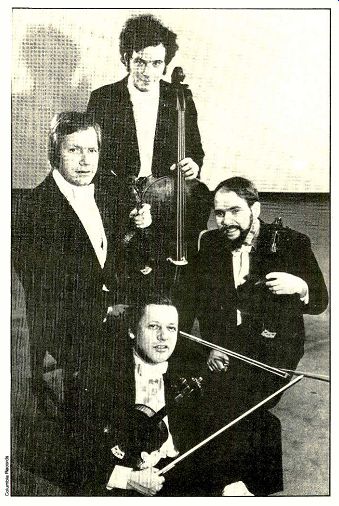
The Juilliard Quartet, top to bottom: Joe! Krosnick, Earl Carlyss, Samuel
Rhodes, and Robert Mann
Schoenberg always believed that he was squarely in the great Classic-Romantic tradition, and these once-outrageous quartets now seem to substantiate this contention. Even the early works, once the cause of riots, now seem thoroughly Romantic, tame, and acceptable in the traditional way (in an essay reprinted in the program booklet Schoenberg implies that since audiences already considered his early late-Romantic works as outrageous he saw no reason not to pursue his demon even further into the forbidden realms of atonality!).
To characterize the numbered quartets briefly: the First is a forty-minute work in a single movement-intense, elaborately worked out, and almost impossible to grasp as a whole. The Second, in spite of stylistic inconsistency, is brilliant and moving--the best of the four. The Third is too studied, too busy, too un-dramatic. The Fourth is truly a traditional work; despite its modernisms (or perhaps because of them) it is full of shape and drama.
The Juilliard Quartet has also mellowed. There is continuity in the person of the first violinist, Robert Mann; all the others are different, younger faces, but they are as excellent musically as those they have replaced. The essential romanticism of the group is more to the fore now, but the old energy is a bit relaxed and things like long line, dynamic ebb and flow, and dramatic or emotional contour have be come more important.
And, finally, since it is being seriously argued, the question should be asked: Are these Schoenberg quartets the great modern successors to Beethoven's? For myself, I don't think I'll ever be able to get all the way through the First without a bit of wool-gathering, and even the Juilliard can't make me love the Third. But the Second and the Fourth are to me great quartets, and I have no doubt that these performances are very close to the last word on all four.
-Eric Salzman
SCHOENBERG: The Five String Quartets. Juilliard Quartet; Benita Valente (soprano, in Quartet No. 2). COLUMBIA M3 34581 three discs $23.98.
Simon Boccanegra: A Superbly Conducted, Splendidly Cast New Recording
GIUSEPPE VERDI'S Simon Boccanegra was a failure at its 1857 première in Venice, but the composer did not believe that the opera should be permitted to slip into oblivion. Many years later, between Aida and Otello, he substantially revised both the libretto and the music with the enthusiastic help of Arrigo Boito. The revised version, which was introduced at La Scala in 1881 with Victor Maurel and Francesco Tamagno (the future Iago and Otello) in the cast, proved Verdi triumphantly right.
To say that Simon Boccanegra has since been firmly established in the international repertoire would be over stating the case. It is not an automatic "box office" opera, but then neither is Falstaff.. Furthermore, it does reveal a certain clash of stylistic elements: much of the 1857 writing, too good for the composer to discard, recalls the Verdi of I Vespri Siciliani, while the music that was added some twenty-five years later strongly suggests Otello.
And yet, this is a marvelously absorbing work; in an inspired performance, all reservations vanish before the humanity of the drama and the power and inventiveness of the music.
Each of the previous three complete recordings of Simon Boccanegra had certain elements of distinction, but Deutsche Grammophon's new version reveals the grandeur of Verdi's score in all its dimensions. La Scala's Giorgio Strehler/Claudio Abbado production has been a source of Milanese pride for several years. It was admired during La Scala's visit to Washington, D.C., during the Bicentennial with virtually the same cast heard in this DG recording, and it is posterity's good fortune to have such a brilliantly prepared and executed performance perpetuated on records.
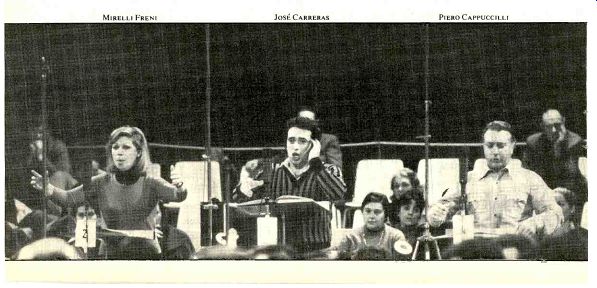
-----------106 MIRELLI FRENI, CARRERAS PIERO CAPPUCCILLI.
Top honors should go to Claudio Abbado for the skill with which he reveals the compassionate intensity of Verdi's music. He draws a positively shimmering sound from the orchestra, chooses just tempos throughout, and guides his singers firmly yet without rigidity. He has an outstanding ensemble to work with. Piero Cappuccilli is unquestionably Tito Gobbi's heir to the title of Most Distinguished Doge of Them All.
Like his predecessor, he is a splendid singing actor, fully in command of the role's manifold challenges, now thundering against his enemies, now meltingly tender with his newly found daughter. There are more expressive nuances and more eloquence and nobility in his singing than he exhibited in the indifferently conducted RCA set re leased several years ago. In the role of Gabriele Adorno, Jose Carreras adds another success to his growing list of impressive characterizations: his singing is stylish, elegant, beautifully enunciated, altogether convincing.
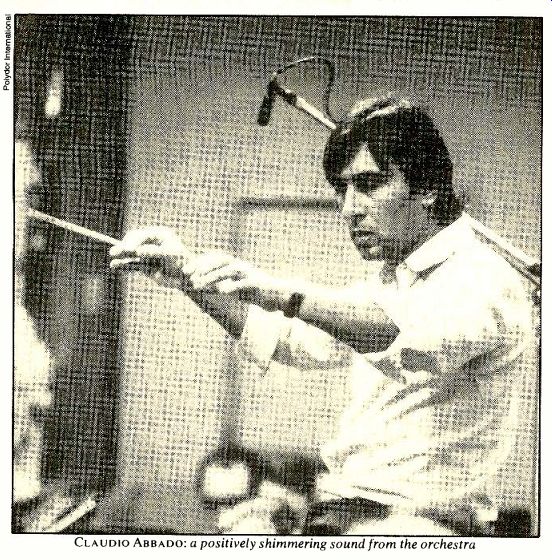
------ CLAUDIO ABBADO: a positively shimmering sound from the orchestra.
Mirella Freni is slightly below top form in her first-act aria, but she goes on to an exquisitely sung and extremely moving Recognition Scene and never wavers thereafter. Nicolai Ghiaurov is a sonorous Fiesco of commanding stature, though I must regretfully note that neither this nor his immediately preceding recorded appearances quite measure up to his own long-held stand ard of excellence. In the Iago-like role of Paolo Albiani, Jose van Dam is simply superb, and bass Giovanni Foiani and tenor Antonio Savastano perform like major artists in their cameo roles.
The La Scala chorus is fine most of the time, but the off-stage women in Fiesco's lacerato spirito" sound slightly off-pitch to my ears. Except for occasional overmiking of the singers, the engineering is as exemplary as the rest of the production, literary presentation included. The score is rendered complete, retaining the usually omitted cabaletta for Amelia and Gabriele in Act 1, Scene 4. Bravi tutti!
-George Jellinek
VERDI: Simon Boccanegra. Piero Cappuc cilli (baritone), Simon Boccanegra; Nicolai Ghiaurov (bass), Jacopo Fiesco; Jose van Dam (bass), Paolo Albiani; Mirella Freni (soprano), Amelia/Maria; Jose Carreras (tenor), Gabriele Adorno; Giovanni Foiani (bass), Pietro; Antonio Savastano (tenor), Captain. Chorus and Orchestra of Teatro alla Scala, Claudio Abbado cond. DEUTSCHE GRAMMOPHON 2709 071 three discs $26.94, 0 3371 032 $26.94.
Enchanting Themes, Surprising Felicities, And Rhythmic Ingenuity In Haydn Symphonies
Neville Marriner and his Academy of St. Martin-in-the-Fields have made a more richly satisfying record than their new Philips coupling of Haydn's Symphonies Nos. 43 (Mercury) and 59 (Fire), it hasn't come my way. Such adjectives as "delightful," "lively," and "stylish" cannot begin to describe the combination of charm and integrity in these performances, which are not merely "lively," but alive, filled with a wit and brilliance that are Haydn's own and not some ill-fitting interpretive overlay. And what remarkably substantial works these "early-middle-period" symphonies are! How filled with enchanting themes and surprising felicities of rhythmic ingenuity and instrumental color! The only serious rival to face Marriner's crisp and sparkling performances is Antal Dorati, in his marvelous complete Haydn symphony cycle for Lon don. The differences between the two conductors' approaches, common to both symphonies, may be summed up as greater mellowness and rhythmic subtlety on Dorati's part, greater viva city and drive on Marriner's. There is also a handsomer sheen on the Academy's strings than on those of the Philharmonia Hungarica, and the winds stand out more effectively in Philips' excellent recording, which is both more full-bodied and more detailed than London's.
The harpsichord is more audible on Philips than the one played by Dorati himself on London, and some listeners might feel this prominence is exaggerated; I don't find it so--and I shouldn't want to exaggerate the differences between the respective performances. The most conspicuous con trast may be noted in the two approaches to the slow movement of No. 43, very deliberate and ruminative un der Dorati, more flowing and outgoing under Marriner; the minuets in both works are further cases in point. But, just as there is nothing somnolent about Dorati's readings, neither are Marriner's by any means of the breath less variety that outlasts its welcome with a second exposure: there is elegance everywhere, poignancy without overstatement in the slow movements, and beneath it all the beat of Haydn's own warm heart.
Surely everyone at all serious about Haydn will want (or will already have) Dorati's full cycle of the symphonies, but anyone that serious will also want to augment that admirable series with other outstanding versions of some of the individual works-Eugen Jochum's Deutsche Grammophon recordings of the "London" symphonies by all means, and now this gem from Marriner, who, as the liner material reminds us, has embarked on a series of recordings of pairs of Haydn symphonies with related sobriquets (Philosopher and Schoolmaster, Military and Drum-Roll, etc.). If the rest of his series is as attractive as this installment, there should be a good deal of ungrudging duplication; even these early(ish) works are, after all, meaty enough to sustain more than one interpretation.
-Richard Freed
HAYDN: Symphony No. 43, in E-flat Major ("Mercury"); Symphony No. 59, in A Major ("Fire"). Academy of St. Martin-in-the-Fields, Neville Marriner cond. PHILIPS 9500 159 $8.98, 7300 524 $8.95.
Remarkable Authority And Rekindling Vigor In Ray Charles' New "True to Life"
WHEN I received for review a new album titled "True to Life," I noticed two things at once: the first was that Ray Charles was back with Atlantic, for which label he had done some of his finest work in the Fifties and Six ties. In recent years he has bounced around various labels, including his own, but his performances were way ward and only occasionally displayed the steamingly intimate, awesomely accomplished communicative gifts that won him the name of "the Genius" some twenty years ago.
The second thing I noticed was the listing of the song titles; spying the George and Ira Gershwin winner How Long Has This Been Going On, I naturally expected to hear one of those treatments that only Ray Charles at his best can lend to a class ballad. I was not disappointed: he is right on target with an interpretation that attains classic status by the time he's sung the first verse.
This is surely Charles' finest album in many years; it recalls and reaffirms all his past glory and demonstrates how indebted many younger singers are to his singing style, vocal mannerisms, and spoken asides. Indeed, every "soul" singer performing today ought to be paying him royalties.
There was once a danger that Charles' unique contributions to music might be, lost amid the yawpings and bawlings of his many conscious imitators, but today many young singers are totally unconscious of what they owe him. Most of them are more than a generation removed from the time Charles first startled the nation in the Fifties with Hallelujah I Love Her So, I Got a Woman, and What'd I Say. If you played this new album for someone in his twenties, he'd probably say that Ray Charles reminds him of some con temporary singer, not knowing that Charles is a primal source. His whoops, gutsy chuckles, and easy banter ("I wanna thank you, little girl") are so much a part of the modern soul singer's performing repertoire that it is often forgotten that Charles invented them.
Those who have followed Charles' career will be delighted to hear that the standout performances on this album equal his superb moments of earlier days. If you thrilled once to I Got News for You, Ruby, I Can't Stop Loving You, and You Don't Know Me, you will thrill again to his impressive authority, his rekindling vigor in such hackneyed material as Be My Love, Oh, What a Beautiful Morning, and the Beatles' Let It Be as well as the afore mentioned How Long Has This Been Going On (which I expect I'll never stop playing).
There are a couple of dull spots here on side two with Anonymous Love and Heavenly Music, two turgid items Charles shouldn't have bothered with, but the pace picks up again with Game Number Nine, a funny talking blues on which he is at his most charming. Also excellent are I Can See Clearly Now, a fine reworking of the Johnny Nash reggae hit, and The Jealous Kind, the sort of rolling-on-the-ground confessional pop-blues at which the Genius just can't be beat.
Charles produced the album himself, and while it is very difficult to be in two places at the same time (haven't quite mastered it myself yet), he brings off his assignments successfully at both microphone and studio control board.
The arrangements (by Larry Mahoberack, Sid Feller, Roger Newman, and Charles himself) vary from big-band jazz to slugging, small-combo backings, and all are outstanding. The word for the whole thing is ... superb.
-Joel Vance
CHARLES: True to Life. Ray Charles (vocals, keyboards); vocal and instrumental accompaniment. I Can See Clearly Now; The Jealous Kind; Oh, What a Beautiful Morning; How Long Has This Been Going On; Be My Love; Anonymous Love; Heavenly Music; Game Number Nine; Let It Be. ATLANTIC SD 19142 $7.98, Ce> TP 19142 $7.97, CS 19142 $7.97.
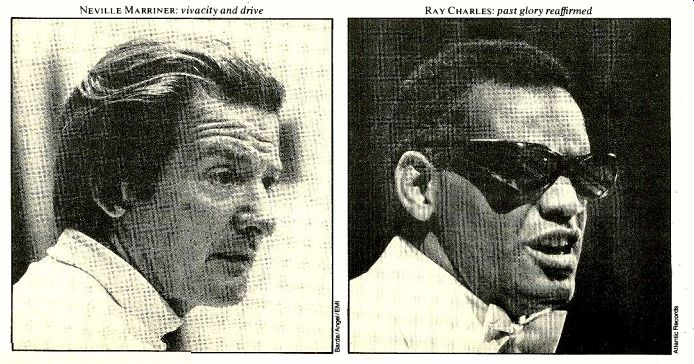
-------------
NEVILLE MARRINER: vivacity and drive; RAY CHARLES: past glory reaffirmed
Jane Olivor in a Program Tailored To an Impressive Talent and Range IN "Chasing Rainbows," her second I album for Columbia, Jane Olivor, who knows how to speak low when she speaks love, presents a program that confirms her as a singer of impressive talent and considerable range. She knows how to husband emotion and then let it go, building somewhat in the Piaf manner to a high-powered display of strength at exactly the right moment, as she does in her tour-de-force handling of The Big Parade, which thoroughly lives up to its title in a production-number treatment complete with military march-rhythm overtones. Or she can be infinitely wistful, as in Donovan's ballad Lalena, a tale of a sufferer who paints her face "with despair" and has a generally sad time of it.
One of Olivor's secrets would appear to be a talent for picking songs that are exactly right for her resources-The French Waltz, for example, which comes across like a miniature Renoir movie with its plot about a pair of lovriage for an old-fashioned wedding ... or is the whole episode just a lonely young girl's dream? But whether this singer is dealing with the pain of parting in It's Over Goodbye, a touching moment of reunion with an old friend in Come In from the Rain, or just being grateful for being loved in You, her taste, her timing, and her superb control of an attractive voice hold the listener firmly in her grasp from one rainbow to the next. You get the feeling, in fact, that if anybody could catch up with that "little bluebird" it would be Jane Olivor. A distinguished effort.
-Paul Kresh
JANE OLIVOR: Chasing Rainbows. Jane Olivor (vocals); instrumental accompaniment. I'm Always Chasing Rainbows; Lalena; The Big Parade; The French Waltz; You Wanna Be Loved; It's Over Goodbye; Come In from the Rain; Beautiful Sadness; You. COLUMBIA PC 34917 $6.98.
John Stewart's "Fire in the Wind": You Can't Keep a Good Singer Down
JOHN STEWART replaced Dave Guard in the Kingston Trio way back at the start of the modern folkie business, and the story goes finally taught the remaining Kingstons the actual names (technically, the letters) of the three or four keys they knew how to play in. Only the critics seem to have kept track of Stewart be tween then and now, probably because he has been, as that story suggests, more musician than entertainer. Comes now his new RSO album, "Fire in the Wind," which will show anyone who cares to listen that he's more than enough of both.
His big, deep, textured, rugged, vulnerable baritone is as good as ever, and the flaws in his songwriting have been polished out. The album, like some of his others, has a recurring motif in it the wind, augmented by a little thunder--but, unlike some of his others, it isn't a matter of a little material stretched too thin; it's rich and varied, with nuance dotted all through it. He's learned how to make repetition work for him instead of against him (a good thing in a songwriter so partial to choruses and refrains), and he's learned to be a little less cryptic with both verbal and melodic vocabularies (there are enough tunes and lyrics to go around this time). And, finally, his up-tempo tempo changers (especially 18 Wheels) have some energy of their own. All of which would not matter if the production and instrumentals weren't also good-in fact, exemplary. You won't often hear so many different effective uses made of acoustic guitars fairly simply played. Best album I've heard in months.-Noel Coppage
JOHN STEWART: Fire in the Wind. John Stewart (vocals, guitar); Reggie Young (guitar); Shane Keister (keyboards); Ken Buttrey (drums); Chris Whalen (bass); other musicians. Fire in the Wind; Rock It in My Own Sweet Time; On You Like the Wind; The Runner; Morning Thunder; Promise the Wind; Boston Lady; 18 Wheels; The Last Hurrah; The Wild Side of You. RSO RS1-3027 $6.98, (.0 8T1-3027 $7.97, CD CT 1-3027 $7.97.
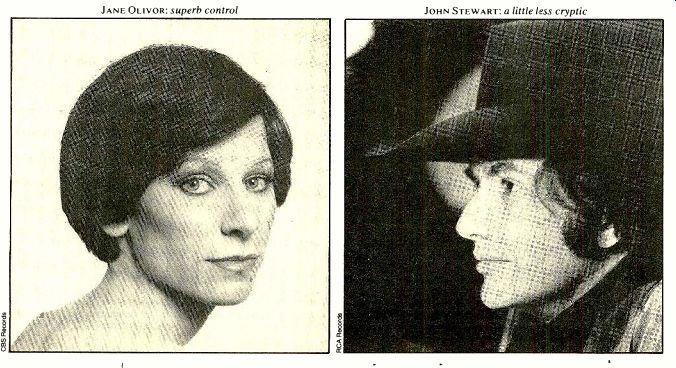
------ JANE OLIVOR: superb control; JOHN STEWART: a little less cryptic.
Also see:
BEST RECORDINGS OF THE PAST TWENTY YEARS: Our reviewing panel selects the best recordings of the past twenty years
Source: Stereo Review (USA magazine)